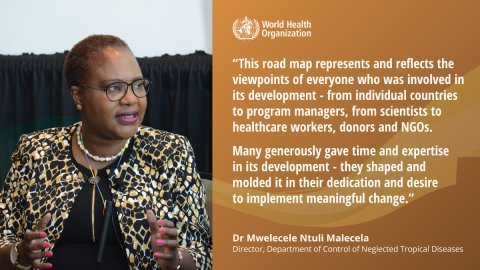Landmark road map for NTDs endorsed at 73rd WHA

On Thursday, delegates attending the Seventy-third World Health Assembly overwhelmingly endorsed the new road map for neglected tropical diseases (NTDs) for 2021−2030.
The road map sets out global targets and actions to align and re-focus the work of countries, partners and stakeholders during the next decade, including cross-cutting targets aligned with the Sustainable Development Goals.
Landmark moment
Of the announcement, Tamar Ghosh, RSTMH Chief Executive said, “this is a landmark moment for the neglected tropical disease community and a welcome development in the fight against this set of diseases that still affect billions of people around the world.”
The road map, developed through extensive global consultation, encourages a fundamental shift in approach from disease programmes to cross-cutting approaches, based on the needs of patients and communities.
“The new road map addresses critical gaps across multiple diseases, integrates and mainstreams approaches within national health systems and coordinates action across sectors.
“It also provides us with opportunities to evaluate, assess and adjust programmatic actions as needed over the next decade.”
Dr Mwelecele Ntuli Malecela
Director, WHO Department of Control of NTDs
RSTMH's work on NTDs
RSTMH’s strategy, which came into effect in 2017, prioritises NTDs as one of its areas of organisational importance.
This has included focusing our 2019 Annual Meeting on NTDs and its intersections with mental health, disability, conflict and the built environment, publishing cutting edge research on a range of NTDs, leading a consortium to tackle snakebite and raise its global profile, funding early career researchers to work in these areas and commissioning an upcoming special issue of our scientific journal Transactions on NTDs.
Since March this year, we have been working with Dr Mwele and the WHO on publishing a blog series, Ending NTDs: Together towards 2030.
2030 road map targets

The road map sets global targets and milestones to prevent, control, eliminate and eradicate 20 NTDs and disease groups.
By shifting away from single-disease programmes to integrated approaches, it aims to promote improved coordination and collaboration.
Another distinct feature is to drive greater ownership by national and local governments, including communities.
The 2030 global targets of the road map are to:
- reduce by 90% the number of people requiring treatment for NTDs
- enable at least 100 countries to have eliminated at least one NTD
- eradicate two diseases (dracunculiasis and yaws)
- reduce by 75% the disability-adjusted life years (DALYs) related to NTDs
Huge step forward
“We are thrilled that the road map has been endorsed and, as a Society, are excited to work towards these ambitious targets with our network of members around the world, many of whom are experts in the field of neglected tropical diseases and have dedicated their careers to their eradication.
“The increased focus on cross-cutting issues provides a great opportunity to use learnings across this very diverse set of 20 diseases, and benefit from more joined up approaches. This is a huge step forward towards eliminating NTDs,” said Ghosh.
The new road map replaces the first one published in 2012 and despite progress over the past eight years, many of the targets will not be achieved.
The new road map will advance the NTD agenda, with opportunities to stimulate efforts through comprehensive approaches that require multisectoral collaboration.
